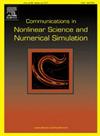基于交叉谱方法的平稳时间序列jensen距离率
IF 3.4
2区 数学
Q1 MATHEMATICS, APPLIED
Communications in Nonlinear Science and Numerical Simulation
Pub Date : 2025-05-15
DOI:10.1016/j.cnsns.2025.108926
引用次数: 0
摘要
熵和互信息率是信息论中的关键概念,分别用于度量两个随机过程之间的平均不确定性和统计依赖性增长。本文介绍了一种测量两个平稳过程之间差异增长的距离速率,称为jensen -距离速率(JDR),它基于谱密度和交叉谱密度。我检查分数噪声作为一个弱平稳过程的具体情况,其中计算渐近JDR,数值结果证明了该方法的性能。此外,我提出了一个基于Blackman-Tukey谱估计的样本JDR估计器。最后,对臭氧监测网的应用展示了时间序列数据的估计JDR,突出了建议的距离率在时间序列分析中的实际效用,包括最大/最小浓度和日内季节性。本文章由计算机程序翻译,如有差异,请以英文原文为准。
Jensen-distance rate for stationary time series based on cross-spectral methods
Entropy and mutual information rates are key concepts in information theory that measure the average uncertainty and statistical dependence growth between two stochastic processes, respectively. This paper introduces a distance rate measure for discrepancy growth between two stationary processes, termed the Jensen-distance rate (JDR), which is based on spectral and cross-spectral densities. I examine fractional noise as a specific case of a weakly stationary process, where the asymptotic JDR is computed, and numerical results demonstrate the method’s performance. Additionally, I propose a JDR estimator based on the Blackman–Tukey spectral estimator for samples. Finally, an application to an ozone monitoring network showcases the estimated JDR for time series data, highlighting the practical utility of the proposed distance rate in time series analysis, including maximum/minimum concentrations and intra-daily seasonality.
求助全文
通过发布文献求助,成功后即可免费获取论文全文。
去求助
来源期刊

Communications in Nonlinear Science and Numerical Simulation
MATHEMATICS, APPLIED-MATHEMATICS, INTERDISCIPLINARY APPLICATIONS
CiteScore
6.80
自引率
7.70%
发文量
378
审稿时长
78 days
期刊介绍:
The journal publishes original research findings on experimental observation, mathematical modeling, theoretical analysis and numerical simulation, for more accurate description, better prediction or novel application, of nonlinear phenomena in science and engineering. It offers a venue for researchers to make rapid exchange of ideas and techniques in nonlinear science and complexity.
The submission of manuscripts with cross-disciplinary approaches in nonlinear science and complexity is particularly encouraged.
Topics of interest:
Nonlinear differential or delay equations, Lie group analysis and asymptotic methods, Discontinuous systems, Fractals, Fractional calculus and dynamics, Nonlinear effects in quantum mechanics, Nonlinear stochastic processes, Experimental nonlinear science, Time-series and signal analysis, Computational methods and simulations in nonlinear science and engineering, Control of dynamical systems, Synchronization, Lyapunov analysis, High-dimensional chaos and turbulence, Chaos in Hamiltonian systems, Integrable systems and solitons, Collective behavior in many-body systems, Biological physics and networks, Nonlinear mechanical systems, Complex systems and complexity.
No length limitation for contributions is set, but only concisely written manuscripts are published. Brief papers are published on the basis of Rapid Communications. Discussions of previously published papers are welcome.
 求助内容:
求助内容: 应助结果提醒方式:
应助结果提醒方式:


